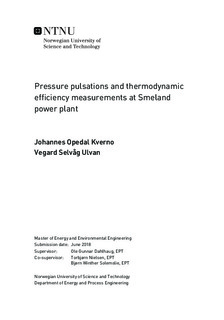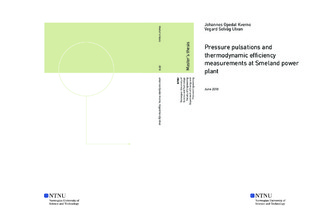| dc.description.abstract | In this master thesis, the cause and solution of a problem at Smeland power plant have been thoroughly investigated. The power plant has for years experienced severe pressure pulsations in their Francis turbine at full load, and the owner, Agder Energi, wanted to know why and what could be done to stop the pulsations.
In order to fully understand the problem, measurements of both the pressure pulsations and efficiency were made. The pressure pulsations were measured using five pressure transducers; two on the draft tube cone 180° apart, one before the main inlet valve, one on the inlet before the spiral casing, and one on the labyrinth leakage water. The efficiency was found using the thermodynamic method, mainly measuring the temperature increase and pressure drop before and after the runner. To find a solution to the problem, air injection was fully tested through a check valve that went through the runner in the centre. To measure the effect of air injection, two pressure transducers were placed on the draft tube cone as done previously. To measure the amount of air, an orifice plate was placed in the air pipe, and the pressure drop and temperature were measured. This allowed for a calculation of the air flow rate.
The hydraulic efficiency measurements showed a runner with seemingly unchanged efficiency from the commissioning measurements in 1985. This indicated that the pressure pulsations had no effect on the efficiency, or has been present in both measurements. Air injection had apparently no effect on the efficiency. The peak-to-peak pressure in the draft tube cone had a magnitude of about 20 % of the design head in the worst point of operation. Injecting 1,266 kg/min of air reduced the peak-to-peak pressure by about 97 %. The standing hypothesis is that the pressure pulsation problem at Smeland power plant stems from a full load vortex bubble oscillating and resonating with the penstock and/or outlet tunnel. Injecting air would change the bubble's volume, and therefore its eigenfrequency, pushing it out of resonance. To deal with the pressure pulsations, it is recommended that Agder Energi implement an air injection system at Smeland power plant, that pumps in an adequate amount of air around full load. | |

